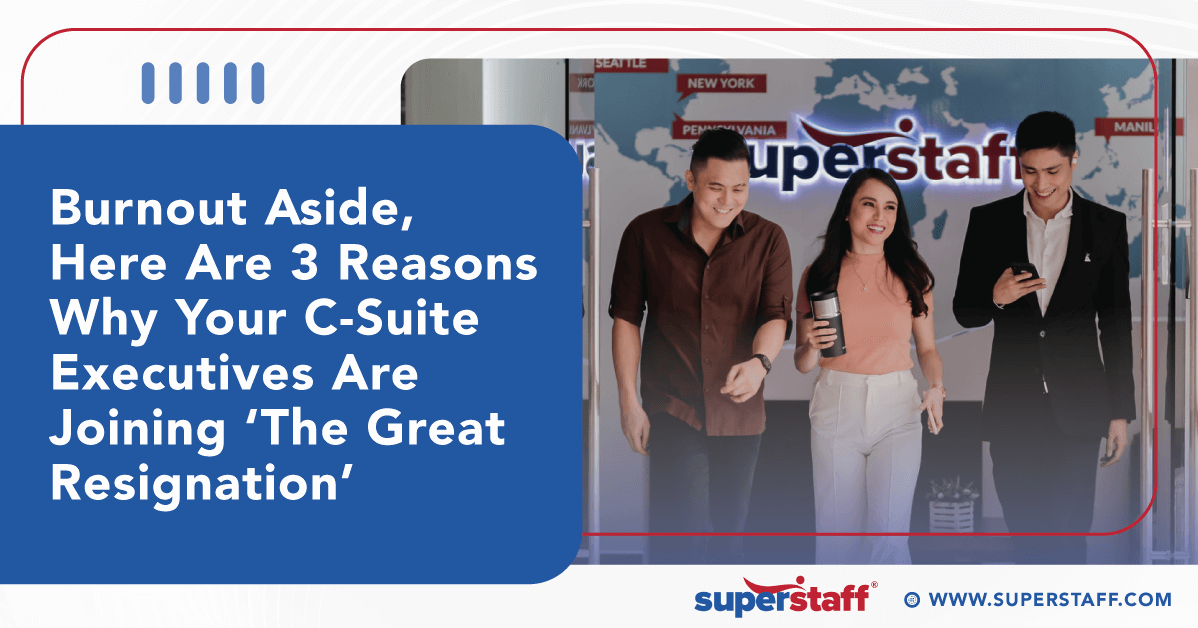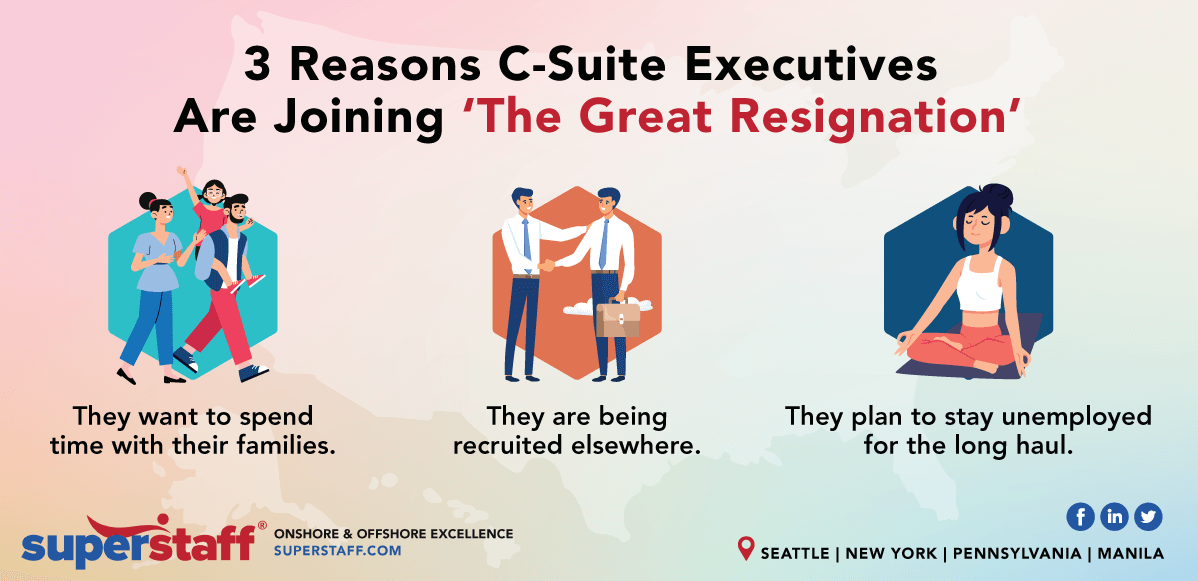
Here’s an interesting twist: Anthony Klotz, the professor who first predicted and coined “The Great Resignation,” resigned in April from Texas A&M.
Following the series of unprecedented events in the labor market, many can’t help but ponder, could America’s turbulent workforce get even more surprising?
Apparently, yes.
The plot thickens, and the stakes get higher as another set of casts enters the picture. Many of America’s top C-suite executives, including Starbucks’ Kevin Johnson, Disney’s Bob Iger, and Amazon’s Jeff Bezos, have joined the “The Great Resignation” wave.
C-Level Great Resignation Statistics
While most of the 47.8 million workers who resigned last year were low-wage and frontline workers, the trend has slipped through the boardroom doors. Take a look at the following C-level resignation statistics:
- October 2021 recorded the second-highest number of CEO resignations with 142 quits.
- Another 106 CEOs resigned in December 2021.
- CEOs who resigned in the fourth quarter of 2021 increased by 16% yearly.
What’s behind the exodus of America’s top-brass talents? How can you prevent “The Great C-Suite Resignation” from crippling your company or halting its growth? Let’s probe deeper.
3 Reasons C-Suite Executives Are Joining ‘The Great Resignation’
1. They want to spend time with their families.
We’ve seen this time and again in many movies. Throughout most of the film, the main character focuses on climbing the ladder of success but later realizes that what’s on top of that ladder pales compared to what they have at home.
This narrative is more accurate than ever among C-suite executives. After spending years living with the intense pressure and demands of their roles—which tripled since the pandemic—many corporate leaders vacated their seats to spend more time with their families.
On average, CEOs spend less than 10 hours a day at work during weekdays. However, the job of an executive is not at all confined to the timeclock. Counting hours spent working on weekends, sitting on an extended business trip, networking while playing golf, and making a quick client call while on vacation, an average CEO’s workweek goes as high as 70 hours.
“What I kept hearing was, ‘Before the pandemic, I arranged my whole life around work,’ but coming out of the pandemic, people said, ‘I need work to work around my life.’” –
Anthony Klotz
Like the rest of the workers who joined “The Great Resignation,” many of America’s top executives want to regain control of their time. Even those who did not drop out of the workforce altogether have taken on new roles that afford them greater flexibility, such as doing short-term consultancy projects, writing books, and teaching yoga. All these suggest that corporate America’s bosses want to be the bosses of their own lives.
2. They are being recruited elsewhere.
Remote work has enabled recruiters and employers to reach a larger pool of candidates easily and less expensively. If you feel like your top-performing executives are not getting a handsome offer from another company, think again. According to a Gallup study:
- 1 in 4 U.S. employees say they have been recruited in the last quarter.
- 1 in 10 employees who are not looking for new opportunities have been recruited in the previous quarter.
- The number of actively recruited non-job seekers has increased by 57% since 2015.
In today’s hot labor market, no employee is out of the recruiters’ radar. Even those engaged at their current work and not actively looking for jobs are sought out. Recruiters are also getting even more creative with their offers and counteroffers, adding tangible and intangible perks into an already-lucrative compensation package.
3. They plan to stay unemployed for the long haul.
Executives who joined “The Great Resignation” were swarmed by offers from headhunters as soon as—or even before—they set one foot out the exit door. However, many of them are not keen on going back to the rat race. They plan to savor their newfound freedom by doing things far from their fast-paced lives as decision-makers.
After all, compared to most average workers, executives have the luxury of being out of work for a more extended period. In fact, many CEO resignations were not driven by finances. Their reasons are not different from the millions of workers who quit jobs and do not plan to return to the workforce anytime soon. Most executives are taking time off to:
- Realign their priorities and “sort out their lives.”
- Reevaluate their relationship with work.
- Lead healthier and more balanced work lives.
- Pursue their passions and other new ventures.
Indeed, even the most successful corporate leaders are not immune to the so-called pandemic epiphanies. Just like the employees who make up the rest of “The Great Resignation” statistics, CEOs, CFOs, and COOs are looking for more out of work than another digit on their paychecks.
Read More: As ‘The Great Resignation’ Persists, What Should Your Employee Value Proposition Look Like in 2022?

How You Can Mitigate C-Level Resignation and Its Impact
Succession Planning
Leader cultivation is imperative to the long-term health of any organization. Even without “The Great Resignation,” executive turnover is a reality that must be prepared for through succession planning. It is also an excellent way to retain key employees.
But as the workforce and workplace become increasingly complex, building a strategy to develop potential leadership successors becomes increasingly challenging.
Today’s leaders require a whole new skill set to thrive. Traditional leadership strengths, such as business acumen, foresight, and strategic management, are still relevant and even more needed as the workplace heads toward an uncertain future. However, these qualities alone are not enough.
Leaders need to recognize the importance of embracing a human-centered approach to leadership. Employees demand more from employers and leaders. Aside from possessing traditional business skills, effective leaders are expected to:
- Nurture employees’ entire well-being, from mental to financial.
- Promote a physically and psychologically safe workplace and culture.
- Display high ethical and moral standards.
- Commit to making a positive difference in society.
- Empathize with employees authentically.
Above everything, today and tomorrow’s leaders must know how to inspire the members of the workforce. Succession planning, therefore, must involve a greater deal of self-reflection and development of soft skills and emotional intelligence.
One unconventional and excellent way to expand your team’s expertise and, at the same time, equip your future leaders with crucial and relevant skills is through outsourcing.
As the practice involves collaborating with professionals from all parts of the globe, potential leaders get the unique opportunity to work with people coming from diverse cultures, points of view, and backgrounds, enabling them to expand their perspectives and enhance their conflict management and people skills.
Talent Pipelining
Most organizations are reactive when filling positions, beginning engaging candidates only when positions become available. This practice is becoming more, if not already, irrelevant and inefficient, especially considering the labor turnover rate today.
Building a talent pipeline is an effective strategy to have a steady stream of potential hires. By maintaining a database or pool of quality candidates, you can skip several initial recruitment stages every time a need to fill a position rises. A healthy talent pipeline allows you to:
- Respond to immediate hiring needs efficiently.
- Reduce time-to-hire significantly.
- Be closer to passive and more qualified candidates.
- Enhance your employer branding.
Although talent pipelining helps simplify and speed up the recruitment process, it requires a lot of work. It is not just about collecting candidate information. One must be hands-on and proactively invest time and energy in engaging, communicating, and nourishing relationships with potential recruits.
There is no one-size-fits-all approach to building a talent pipeline. You have to develop a strategy appropriate for your unique goals and needs. Additionally, you have to tailor the engagement solutions based on the position. Building a leadership pipeline, in particular, can be challenging due to the smaller population of executives and the meticulous qualifications required for the role.
This is among the reasons why many companies outsource recruitment. RPO or recruitment process outsourcing providers specialize in talent pipelining across industries. By leveraging the expertise and resources of a recruitment process outsourcing partner, you can develop a framework and access solutions designed to improve and diversify your talent pipeline.
Read More: Where To Find and How To Recruit Untapped Workforce Amid ‘The Great Resignation’
Turn to SuperStaff for Recruitment Process Outsourcing Services
With “The Great Resignation” happening across the board, businesses must acquire adequate support to mitigate its impact. SuperStaff offers comprehensive recruitment process outsourcing solutions to enable U.S. businesses to withstand and thrive amid the tumultuous labor climate.
We have been instrumental in helping companies across continents build healthy and diverse talent pipelines and meet hiring goals. Allow us to deliver the same excellent results for your brand. Contact us today.






